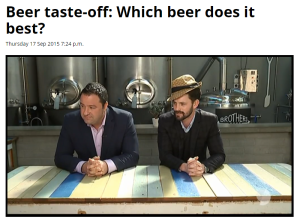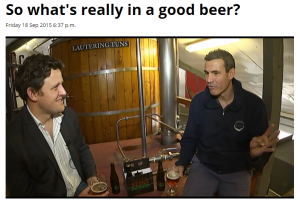I spent a few hours on Saturday in the beer-bunker that is Hashigo Zake, in the company of two-dozen-or-so like-minded folks and enjoying the Brewers Guild Awards beaming at us from Auckland over a mercifully-dependable livestream. It was a properly marvellous occasion,1 and the Guild (with new host, Hilary Barry) put on a great show. It’s truly heartening to see the gradual evolution of the industry, particularly the maturation of the “craft”2 corner thereof as it becomes less of a niche or subculture and settles into being just part of the landscape. But as if on cue, two abysmal videos surfaced late last week3 — both from TV3’s ‘Story’ program — to remind us how far we have to go in terms of generalised acceptance and understanding. If you can stand the cringe, I think they’re worth watching for how instructively shallow and terrible they are.

The first is styled as a taste-off between craft beer and quote-unquote “normal beer”, with the former signified by hats, hipsters and IPA and the latter bluntly equated with lager. Through four rounds of anonymous beers from unidentified styles served in a misnamed bar (“Beer Brothers”), the contestants follow their tired generational stereotypes and spend a suprisingly long time saying not very much of substance. The comparisons, kept completely mysterious, don’t really illuminate anything: were the beers they put up against each other even trying to do similar things or was this pure apples-to-oranges time-wasting that forgot that everything is best in its right place and something calm and friendly isn’t automatically inferior to some-other-thing attention-grabbing and audacious? Who the hell knows?

Weirder and worse, though, is the rambling chat with Scott McCashin.4 It puts the “taste-test” piece to shame in terms of its wordy emptiness, with bonus side orders of contradiction and claptrap. The website dutifully regurgitates McCashin’s nonsense claim to being New Zealand’s first craft brewery — a boast which rings hollow whatever your definition of that contentious term5 — and you could easily come away from listening to the piece knowing a lot less than you did going in. It’s an absolute mess: mainstream beers are all ‘thinner’ and brewed with ‘less ingredients’ and perhaps particularly ‘less hops’, seemingly across the board — and Heineken fills a strange duel role as the name-dropped example of something flavourless and disappointing and the hoppy interesting thing that started a revolution. Craft beer, he says, “doesn’t have sugar added” which will come as a huge shock to generations of Belgians and Brits and others — if you don’t understand that sugar isn’t an inherently evil ingredient and can be used to make certain types of beer more enjoyable (rather than merely for cost-cutting) then you need to stop “educating” the public immediately and maybe reconsider whether this is the right business for you. Scott’s sole good point about the wide appeal of craft beer is lost under a mountain of muck and the reporter does nothing to tease out any clarity or coherence, instead belaboring a weird analogy about religion and dragging out the old “extreme beer is for hipsters” trope. His late realisation that all this uncritical dreck amounts to a mere ad is depressingly tossed aside.
Both of these pieces should’ve been spiked. There’s just no there there, in either of them. They add precisely nothing, merely reinforcing old clichés and (worse) muddying the water. The latter, in particular, is hopefully an embarrassment to the producer, editor, reporter and subject alike. If the brewery are delighted with it, or the Brewers’ Guild and/or their PR firm have chalked these up as marketing wins,6 then excuse me while I despair. There is a lot of good stuff going on in the beer-related and beer-adjacent media.7 Some of it, to my delight, percolates into the mainstream and is presented to diverse new eyeballs. But we all need to do more, and do it better, to break through the stereotypes and misinformation and nonsense.
- There’s plenty to digest in the results themselves, and I’m working on something of a debrief, but it has (perhaps inevitably) descended into spreadsheets and close readings of the rulebooks and going back over past years’ results. If you’re asking for genuinely sophisticated analyses — and I sense that you are — you gotta gimme some time.
- Emphatic scarequotes, here, since I’m still not going near the definition question. But you know what I mean.
- Thanks, if that’s the word, to beer writer Geoff Griggs who shared a link to the second one and introduced me to them.
- Which seems, from their website, to’ve aired the next day. But it’s all rather vague and I didn’t see these pieces on actual-TV, so I honestly have no idea if it was just a “web extra”.
- Briefly, again: If it’s at the nebulous end and concerned with flavour and authenticity, then they hardly seem a good candidate when their origins are in knocking out maybe-slightly-dialled-up versions of the gold and darker lagers of their day and having the gall to put out a blend of the two under the wildly-misleading name “Real Ale”. If you’re more concerned with the ownership model of these breweries, then a) I’d remind you that the term “independent” already exists and needn’t be coextensive with “craft”, and b) they sure do gloss over the fact that Terry McCashin is our country’s pioneering sell-out and the company they’re speaking from is not the one he founded, which is now mere label in the wider Lion portfolio.
- Interestingly, Emma McCashin — sister-in-law of Scott and either his boss or his colleague, depending on how they’ve structured the company — is the Guild’s new President, so the two ponderings aren’t as far removed as they might be.
- Topical shout-out to my comrade Jono Galuszka, your freshly-minted Beer Writer Of The Year as of about forty-four hours ago.

31 seconds into the first one and I’ve already got a rage twitch on. WTF is ‘normal’ beer?
McCashin’s mumbling ramble would put me off craft beer.